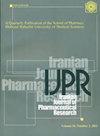Bioinformatics and Gene Expression Omnibus Analysis of Key Candidate Genes and Pathways Associated with Femoral Head Necrosis
IF 1.8
4区 医学
Q3 PHARMACOLOGY & PHARMACY
引用次数: 0
Abstract
Background: Femoral head necrosis (FHN) is a debilitating bone disease affecting an estimated 8 million people worldwide. Although specific drugs for FHN have limitations, targeted therapies have shown promising results. The significance of this study is underscored by the high prevalence of FHN, the limitations of current treatments, and the potential of targeted drugs and natural compounds for effective therapeutic interventions. Objectives: This study aimed to explore the genetic landscape and associated pathways of FHN through bioinformatics analysis of Gene Expression Omnibus (GEO) data and molecular docking simulations targeting specific enzymes implicated in FHN. Methods: Differentially expressed genes (DEGs) in FHN samples were identified from GEO datasets, specifically accession number GSE123568 (Platform: GPL15207). Functional enrichment analysis was performed using the Database for Annotation, Visualization, and Integrated Discovery (DAVID) to identify enriched pathways and Gene Ontology (GO) terms. Additionally, a protein-protein interaction (PPI) network was constructed using the STITCH (search tool for interaction of chemicals) database, which helped identify top hub genes and proteins. Molecular docking was conducted against key proteins using compounds from the topical chinese herbal medicine (TCHM) database associated with FHN. Results: The study provided a comprehensive bioinformatics analysis of key candidate genes and pathways associated with FHN, which may serve as potential therapeutic targets. It was found that FHN is associated with mitogen-activated protein kinases (MAP4K4/ MAPK8/ MAPK9) and interleukins (IL1b/ IL19/ IL26). Molecular docking results showed strong interactions of traditional Chinese herbal compounds through hydrogen bonding and electrostatic interactions at the active sites of the top ten target proteins associated with FHN. Conclusions: The study confirmed that FHN is linked with enzymes such as mitogen-activated protein kinases (MAPKs), interleukins, tumor necrosis factors (TNFs), and VEGFA (vascular endothelial growth factor A). Molecular docking simulations demonstrated that hesperidin, naringin, and curcumin exhibit potent inhibition against key proteins involved in FHN. Future research will focus on elucidating the specific roles of genes associated with FHN and exploring potential therapeutic targets using natural compounds.股骨头坏死相关关键候选基因和通路的生物信息学和基因表达总库分析
背景:股骨头坏死(FHN股骨头坏死(FHN)是一种使人衰弱的骨病,全球约有 800 万人受到影响。虽然治疗股骨头坏死的特效药物有其局限性,但靶向疗法已显示出良好的效果。由于 FHN 的高发病率、目前治疗方法的局限性以及靶向药物和天然化合物在有效治疗干预方面的潜力,本研究的意义尤为重要。研究目的本研究旨在通过对基因表达总库(Gene Expression Omnibus,GEO)数据进行生物信息学分析,并针对与 FHN 有关的特定酶进行分子对接模拟,从而探索 FHN 的遗传图谱和相关通路。研究方法从 GEO 数据集中识别 FHN 样本中的差异表达基因(DEGs),特别是登录号 GSE123568(平台:GPL15207)。利用注释、可视化和综合发现数据库(DAVID)进行了功能富集分析,以确定富集的通路和基因本体(GO)术语。此外,还利用 STITCH(化学物质相互作用搜索工具)数据库构建了蛋白质-蛋白质相互作用(PPI)网络,这有助于识别顶级枢纽基因和蛋白质。利用局部中草药(TCHM)数据库中与 FHN 相关的化合物对关键蛋白进行了分子对接。研究结果该研究对与 FHN 相关的关键候选基因和通路进行了全面的生物信息学分析,这些基因和通路可作为潜在的治疗靶点。研究发现,FHN 与丝裂原活化蛋白激酶(MAP4K4/ MAPK8/ MAPK9)和白细胞介素(IL1b/ IL19/ IL26)相关。分子对接结果显示,传统中草药化合物通过氢键和静电相互作用在与 FHN 相关的前十大靶蛋白的活性位点上产生了强烈的相互作用。结论:研究证实,FHN 与丝裂原活化蛋白激酶(MAPKs)、白细胞介素、肿瘤坏死因子(TNFs)和血管内皮生长因子 A(VEGFA)等酶相关。分子对接模拟显示,橙皮甙、柚皮甙和姜黄素对参与 FHN 的关键蛋白具有强效抑制作用。今后的研究将侧重于阐明与 FHN 相关基因的特定作用,并利用天然化合物探索潜在的治疗靶点。
本文章由计算机程序翻译,如有差异,请以英文原文为准。
求助全文
约1分钟内获得全文
求助全文
来源期刊
CiteScore
3.40
自引率
6.20%
发文量
52
审稿时长
2 months
期刊介绍:
The Iranian Journal of Pharmaceutical Research (IJPR) is a peer-reviewed multi-disciplinary pharmaceutical publication, scheduled to appear quarterly and serve as a means for scientific information exchange in the international pharmaceutical forum. Specific scientific topics of interest to the journal include, but are not limited to: pharmaceutics, industrial pharmacy, pharmacognosy, toxicology, medicinal chemistry, novel analytical methods for drug characterization, computational and modeling approaches to drug design, bio-medical experience, clinical investigation, rational drug prescribing, pharmacoeconomics, biotechnology, nanotechnology, biopharmaceutics and physical pharmacy.

 求助内容:
求助内容: 应助结果提醒方式:
应助结果提醒方式:


